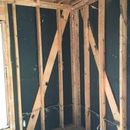Existing fiber board sheathing questions
I am remodeling 1965 story and half brick veneer home located in Charlotte, NC, CZ 3A. Home is built on a pier and brick curtain crawlspace foundation. I have removed all drywall and insulation (paper backed fiberglass batt in stud bays and blown fiber glass above ceilings). There is a drainage gap of approximately 3/4″ to 1″ between sheathing and brick. Sheathing is 1/2″ Johns Manville insulboard (asphalt impregnated fiberboard). No WRB on sheathing. All framing appears in very good condition with only wood rot found on joists caused by leaking plumbing fixtures. I will not be removing brick veneer so do not have access to exterior side of sheathing. Plan to use blown cellulose to insulate wall cavities. Have not decided on method to insulate attic or roof but having duct work in semi conditioned space is high priority. I do plan to seal and condition crawlspace. To reduce vapor diffusion and add some protection against bulk water I am considering spraying interior side of fiberboard with a fluid applied smart membrane material. Attached are two photos of interior side of fiberboard sheathing. Will my plan cause some unforeseen negative consequences? Will application of smart membrane provide benefits or overall is it a waste of money? I am open to other options that might work better. Thank you.
GBA Detail Library
A collection of one thousand construction details organized by climate and house part











Replies
Hi Slowlylearning.
What specific product are you considering?
Brian I have only recently considered this option and have looked at proclima Visconn and Visconn Fiber sold by 475 High Performance Building Supply. I am open to all ideas. Thanks
Visconn opens up to 20+ perms when the moisture content of the fiberboard/Visconn is high, and is only low-permeance when the fiberboard moisture content is low, which probably isn't what you're looking for. In an air conditioned building it's better to have the exterior layers be low-perm when the exterior side moisture drives are high- this does the opposite.
A 1" shot of closed cell polyurethane would run about 1 perm over a wide range of moisture conditions.
But if the framing lumber was in good shape even with the vapor-openness of the asphalted fiberboard (about 15-20 perms) the Visconn won't create a problem, and would probably lower the average cooling season moisture burden despite being fairly vapor open under cooling season conditions. Whether it's enough of a benefit to be "worth it" may be questionable though. Testing and rectifying any air tightness of the fiberboard layer is fairly high priority, and to the extent that Visconn would air seal the fiberboard it may have value.
Dana, I am still working on this project as I am doing much of work myself. My fiberboard dilemma is still out there as I am just now expecting my trades to wrap up by end of December. In meantime I came across a 2016 article on this site by Allison Bailes. In the article he described his addition of 1/2" XPS in stud bays. His solution makes a lot of sense to me and I am considering applying it to my project. Do you have any feedback you are willing to share with me? Also, addition of XPS will use 1/2" of space leaving 3" for insulation ( considering mineral wool or fiberglass). Will compressing R-15 work or should I seek another type insulation?
Allison Bailes' article link is https://www.greenbuildingadvisor.com/article/how-i-fixed-my-leaky-underinsulated-exterior-wall.
Thanks.
Thank you Dana. Appears Visconn could be step in right direction but with borderline moisture burden reduction benefit and good air sealing properties it is still an option. Homeowner concern over stories regarding off-gassing from spray foam eliminate that as an option. Does anyone have other suggestions for vapor control and air sealing that can be applied from interior side of fiber board? Trying to achieve maximum benefit while doing no harm. Thanks again.